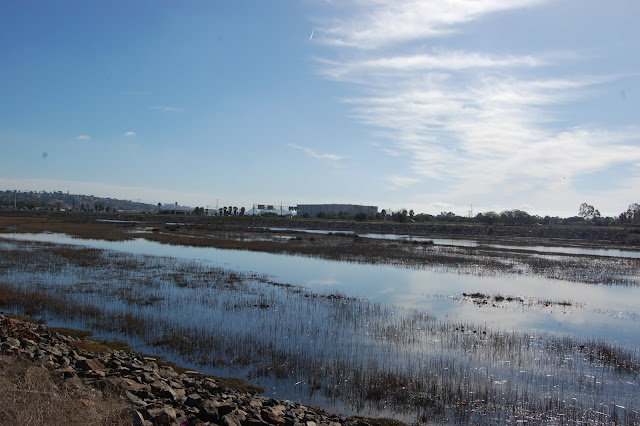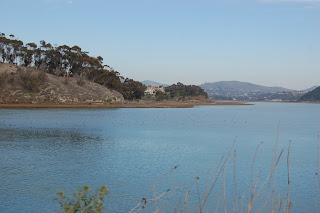San Diego River is on the Pacific Flyway for migratory birds. The green line in the below image is Waterfowls Pacific Flyway.
We went there last Sunday and saw at least 500 birds at one time! Our eyes were just not enough to identify so many new birds!
What amazed me was on the two sides of river were highways and Interstate 5 just crosses the river. But still so many birds on the shores of the river. Animals seems really are not asking for too much.
We never see Ruddy Duck in San Diego before. Ruddy Duck is pretty easy to identify. It has a very bright baby blue bill. And of course, the body is duck-shaped. Here it is with an American Coot.
To identify American Wigeon, the most easy way is to look if the male duck has white crown/forehead and a very bright shiny green speculum. It's very obvious no matter when they in flight or in rest.
You won't see blue-wings when blue-winged teals in rest. The big blocks of blue on their wings are only very obvious when they in flight.
Still not too hard to identify them though. The adult male has a greyish blue head with a white facial crescent, a light brown body with a white patch near the rear and a black tail.
If you see Cinnamon Teals, I seriously don't think you would miss them. Just like their name, their body is really cinnamon color! Their whole body is redish cinnamon with red eyes. Their color is much more red than brown. You will believe when you see it.
The photo below you can see the shape and color of a Cinnamon Teal and two Blue-winged Teals on flight. Now you can really see the light blue blocks on their wings. The first Blue-winged Teal is a male and the following is a remale. Look at the male got the white facial crescent but the female doesn't.
We also saw some Clark's Grebes. Grebes are freshwater diving birds. Grebes always look a little strange to me. They are unlike ducks, unlike any wading birds. and neck/head shape is almost like snake turtle head shape. Talking about behaviors, unlike ducks, they dive to fish instead just fish on surface. They dive in water for sometimes half a minute to fish.
In Southern California, Clark's Grebe and Western Grebe are common. The difference between these two are the bill shape and color. Clark's Grebe has red bill and a little bit upturn. Western Grebe has pale yellow and straight bill. So which Grebe it is on the below picture? Yes, Western Grebe.
Below are some photos that show the bigger view of the river.
See the little black dots in the photo below? They are all birds in rest. :) Very difficulte to tell which birds they are though under that kind of light and distance.
Look at the landing Great Egret! Isn't it beautiful?
Southern Wildlife Preserve is also one of the areas for California Least Tern nesting. It's like a sandy flat area for California Least Terns to lay their eggs on it without people or cars accidentally step on them.
One of the surprises of that day was a California Brown Pelican got really close to us to dive and fish.

















































